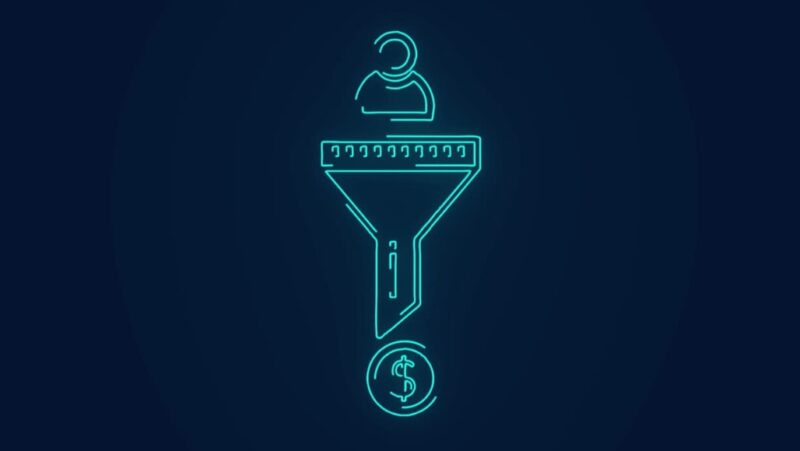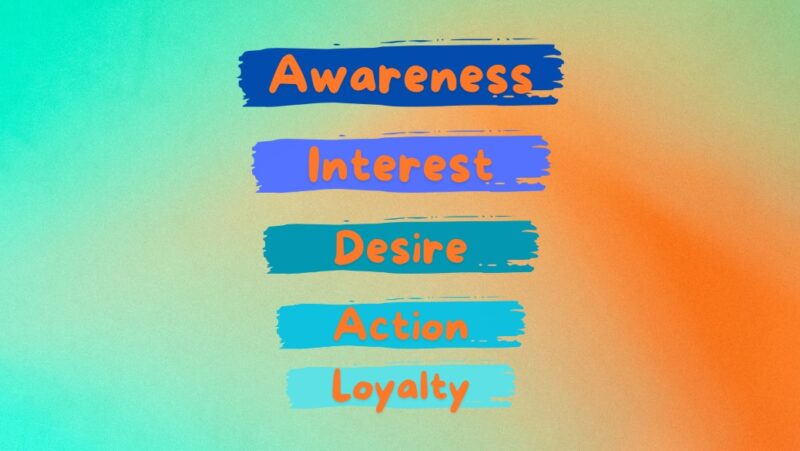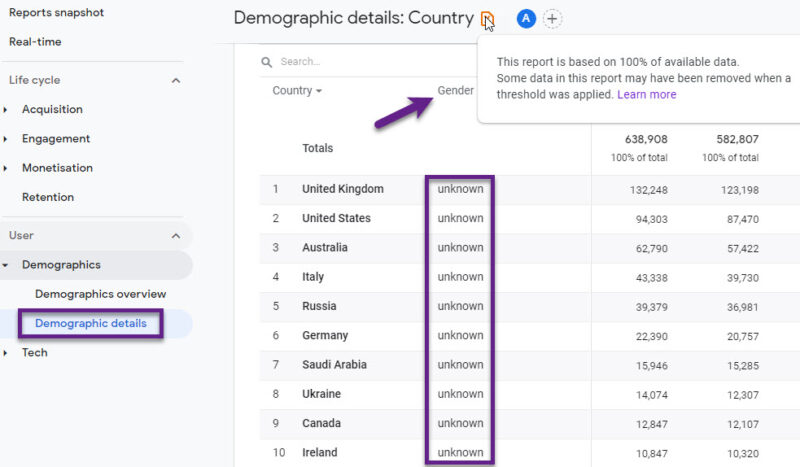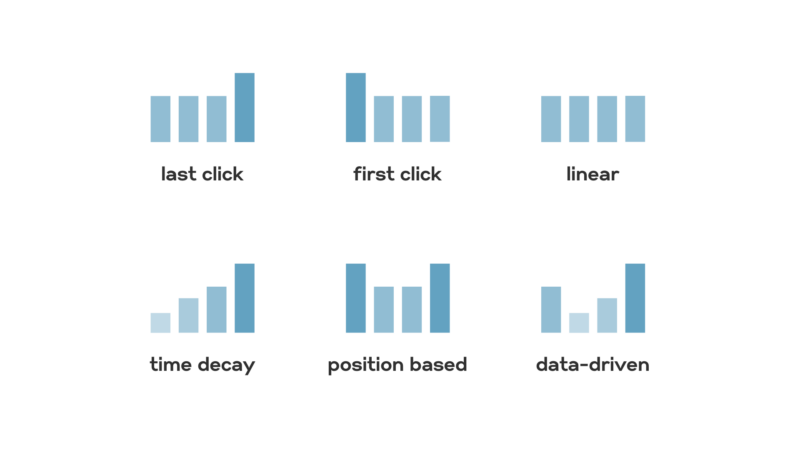Conversion funnel analysis is a critical component of digital marketing that involves examining each stage of a customer’s experience, from initial awareness to final conversion and beyond.
By breaking down the customer experience into manageable stages, businesses can implement targeted strategies to enhance the overall effectiveness of their marketing efforts.
The Conversion Funnel
The conversion funnel consists of several key stages, each representing a different phase of the customer experience.
1. Awareness
The awareness stage is the initial point of contact where potential customers first encounter a brand. The crucial phase sets the foundation for the entire customer experience and is often where first impressions are formed.
At this stage, potential customers become aware of a brand’s existence and its offerings, typically through exposure to various marketing channels. Here are the most important channels:
- Social Media: Platforms like Facebook, Instagram, Twitter, LinkedIn, and TikTok are powerful tools for raising brand awareness.
- Search Engines: Search Engine Optimization (SEO) and Search Engine Marketing (SEM) play a vital role in increasing brand visibility.
- Advertisements: Display ads, banner ads, and video ads on various websites and platforms help in capturing the attention of potential customers.
- Content Marketing: Creating and distributing valuable content such as blog posts, articles, infographics, and eBooks can attract potential customers who are looking for information related to their interests or needs.
- Traditional Media: Traditional media such as TV, radio, print ads, and billboards still play a significant role in raising brand awareness, especially in reaching a broader, more diverse audience.
- Word of Mouth and Referrals: Personal recommendations from friends, family, and influencers can significantly impact brand awareness.
2. Interest

Once potential customers are aware of the brand, the next step is to engage them and nurture their interest. What are the most effective strategies for engaging customers?
Content Marketing
Creating high-quality, relevant content is essential for maintaining interest. This includes:
- Blogs: Regularly updated blogs that cover topics relevant to the industry, customer pain points, and solutions provided by the brand.
- Videos: Engaging video content such as explainer videos, tutorials, behind-the-scenes looks, customer testimonials, and product demonstrations.
- Infographics: Visual representations of information can make complex data more digestible and appealing.
Email Newsletters
Email marketing remains a powerful tool for nurturing interest. Regular newsletters can keep potential customers informed about new products, upcoming events, and industry news.
Personalized emails based on user behavior and preferences can increase relevance and engagement.
Segmented email lists ensure that content is tailored to the specific interests and needs of different audience segments.
Also, feel free to check our Gmail vs Yahoo Mail comparison.
Webinars and Live Events:
Hosting webinars, live Q&A sessions, and virtual events allows for real-time interaction with prospects.
These events provide an opportunity to showcase expertise, answer questions, and engage directly with the audience.
Offering exclusive insights, demonstrations, and behind-the-scenes looks can further pique interest.
Social Media Engagement:
Active and consistent engagement on social media platforms helps in maintaining interest. This involves:
- Regular Posting: Sharing valuable content regularly to keep the brand top-of-mind.
- Interactive Content: Polls, quizzes, and contests that encourage participation and interaction.
- Responding to Comments: Engaging with followers by responding to comments, questions, and messages promptly and thoughtfully.
3. Desire

In the desired stage, the focus shifts to creating a need or desire for the product or service.
It is something that can be achieved by showcasing the unique benefits and features of the offerings.
Testimonials, case studies, and success stories can be powerful tools to build desire and convince prospects of the product’s value.
4. Action

The action stage is where the conversion happens. This could be a:
- Purchase
- Sign-up
- Other desired action.
The goal here is to make the process as seamless and straightforward as possible. Clear calls-to-action, easy navigation, and a user-friendly checkout process are crucial at this stage.
5. Loyalty

After conversion, the experience doesn’t end. The loyalty stage focuses on retaining customers and encouraging repeat business.
Excellent customer service, loyalty programs, and regular engagement through personalized communication can help in building a loyal customer base.
What are the Benefits?

Now let us take a look at the most important benefits:
1. Insight into Customer Behavior
Funnel analysis provides deep insights into how customers move through different stages of the buying process.
Through analyzing the funnel, businesses can gain a view of customer preferences, behaviors, and pain points, allowing for more effective and targeted marketing efforts.
Identifying Stages of Engagement:
Funnel analysis helps businesses identify the specific stages at which customers interact with their brand.
It includes the initial awareness stage, where potential customers first learn about the brand, to the final conversion stage, where they make a purchase or take the desired action.
By tracking these stages, businesses can understand the experience customers have and the touchpoints that influence their decisions.
Monitoring Interaction Patterns:
By closely monitoring how customers move through each stage of the funnel, businesses can detect patterns in customer behavior.
For instance, they can identify which content formats (blogs, videos, social media posts) are most engaging, which marketing channels drive the most traffic, and which calls-to-action (CTAs) are most effective.
Analyzing Drop-Off Points:
One of the key benefits of funnel analysis is the ability to pinpoint where potential customers drop off in the funnel. These drop-off points indicate stages where customers lose interest or encounter obstacles.
Knowing why customers abandon the funnel at certain stages allows businesses to address these issues, whether by improving user experience, providing clearer information, or offering additional incentives.
2. Optimization Opportunities

One of the primary benefits of funnel analysis is the ability to pinpoint bottlenecks and areas of friction within the funnel.
Optimization opportunities span various aspects of the customer experience, from initial engagement to final conversion and beyond.
Tracking Drop-Off Points:
Funnel analysis enables businesses to track where potential customers exit the funnel.
It could be at any stage, such as failing to complete a sign-up form, abandoning a shopping cart, or leaving a website after viewing product details.
By understanding these drop-off points, businesses can determine which stages of the funnel are causing the most significant loss of potential customers.
Analyzing User Behavior
Detailed analysis of user behavior within the funnel provides insights into what might be causing drop-offs.
For example, heatmaps and session recordings can reveal if users are struggling with navigation, if there are issues with page load times, or if certain forms are too complicated.
Identifying these friction points is crucial for addressing and eliminating them.
Customer Feedback
Customer feedback, such as surveys and reviews, can also highlight areas where the funnel is not performing optimally.
Customers might indicate that they found the checkout process too lengthy, had difficulty finding information, or encountered technical issues.
Qualitative data complements quantitative funnel analysis and provides a clearer picture of the issues at hand.
Steps in Conversion Funnel Optimization
Now let us address the major steps in conversion funnel optimization.
Step #1. Awareness Stage
Generating brand visibility is crucial at this initial stage.
The awareness stage is where potential customers first encounter your brand, making it the foundation of the entire customer experience.
The primary objective is to capture attention and generate interest in the brand, setting the stage for deeper engagement and conversion. Here are the most efficient methods for creating awareness:
Content Marketing
Content marketing involves creating and distributing valuable, relevant content to attract and engage a target audience. Content marketing is an umbrella term that includes:
- Blog posts
- Articles
- Infographics
- Videos
- Social media content
The key is to produce high-quality content that resonates with your audience’s interests and needs, positioning your brand as an authoritative voice in your industry.
Search Engine Optimization (SEO):
SEO is the practice of optimizing your website and content to rank higher in search engine results pages (SERPs). Effective SEO strategies involve:
- Keyword research
- On-page optimization
- Creating high-quality content
- Building backlinks
By improving your search engine visibility, you can attract organic traffic from users actively searching for information related to your products or services.
Targeted Advertising:
Paid advertising can significantly boost brand visibility. This includes:
- Pay-Per-Click (PPC) Ads
- Social Media Ads
- Display Ads
Public Relations and Media Coverage:
Generating media coverage through press releases, media pitches, and public relations campaigns can help increase brand visibility.
Securing coverage in reputable publications and news outlets enhances brand credibility and reaches a wider audience.
Influencer Marketing:
Partnering with influencers who have a substantial following and influence within your target market can amplify your brand’s reach.
Influencers can introduce your brand to their audience in an authentic and relatable manner, driving awareness and interest.
Step #2. Interest Stage

Once awareness is established, the next step is to nurture leads by providing valuable information.
The interest stage focuses on engaging potential customers and keeping them interested in your brand.
Webinars
Webinars are an excellent way to provide valuable information and interact with potential customers in real time.
They allow you to showcase your expertise, answer questions, and provide in-depth knowledge about your products or services.
Webinars can be recorded and shared later, extending their reach.
Product Demos
Offering live or recorded product demos helps prospects see your products in action.
Demonstrations provide a clear understanding of how your products work, their benefits, and how they can solve specific problems. This hands-on approach can significantly boost interest and trust.
Informative Content
Creating and sharing informative content such as whitepapers, eBooks, case studies, and detailed blog posts can educate prospects about your offerings.
The content should address common questions, pain points, and industry challenges, positioning your brand as a helpful resource.
Email Newsletters:
Regular email newsletters keep your brand top-of-mind and provide ongoing value to your audience.
Personalized and segmented email campaigns can deliver targeted content based on the recipient’s interests and behaviors, increasing engagement and nurturing leads.
Step #3. Consideration Stage

During the consideration stage, it’s essential to provide detailed information that helps prospects make informed decisions.
This is a stage that focuses on convincing potential customers that your product or service is the best solution for their needs. methods for assisting decision-making:
Detailed Information
Providing comprehensive product descriptions, specifications, and benefits helps prospects understand exactly what you offer.
This information should be easily accessible on your website, landing pages, and marketing materials.
Addressing Objections
Anticipating and addressing common objections can alleviate concerns and build confidence in your product. It can be done through FAQs, blog posts, and content that specifically tackles potential hesitations.
Showcasing Customer Testimonials
Customer testimonials, reviews, and case studies provide social proof and demonstrate the value of your product through real-world examples.
Positive feedback from satisfied customers can significantly influence prospects’ decisions.
Step #4. Decision Stage

The decision stage is a critical phase in the conversion funnel where potential customers make the final decision to purchase a product or service.
At this point, all previous efforts to build awareness, generate interest, and nurture leads culminate in a decisive moment.
Facilitating this purchase decision involves several strategic actions designed to encourage conversion and ensure a positive customer experience.
Providing Incentives
Offering incentives can be a powerful motivator for prospects who are on the fence about making a purchase. These incentives can take various forms, such as:
- Discounts
- Special Offers
- Loyalty Points
Ensuring a Seamless User Experience
A smooth and hassle-free checkout process is crucial for converting potential customers. Key elements to focus on include:
- Simplified Checkout Process
- Multiple Payment Options
- Mobile Optimization
Clear Calls-to-Action (CTAs):
Effective CTAs guide potential customers toward completing the purchase. To maximize their impact:
- Visibility
- Clarity
- Design
Step #5. Retention Stage

Retaining customers is as important as acquiring new ones.
In fact, customer retention can often be more cost effective and beneficial in the long run, as loyal customers tend to make repeat purchases, refer others, and have a higher lifetime value.
The retention stage focuses on maintaining customer engagement and fostering long-term loyalty through excellent customer service, loyalty programs, regular communication, personalized recommendations, and exclusive offers.
Excellent Customer Service
Providing exceptional customer service is fundamental to retaining customers. This involves:
- Responsiveness: Quickly addressing customer inquiries, complaints, and feedback.
- Problem Resolution: Efficiently resolving issues and going above and beyond to ensure customer satisfaction.
- Proactive Support: Anticipating customer needs and offering assistance before they ask for it.
Loyalty Programs
Loyalty programs reward customers for their repeat business and encourage them to continue engaging with the brand. Effective loyalty programs include:
- Points Systems: Customers earn points for every purchase, which can be redeemed for discounts, free products, or other rewards.
- Tiered Rewards: Offering different levels of rewards based on customer spending or engagement.
- Exclusive Access: Providing loyalty program members with early access to new products, special sales, and exclusive events.
Related Posts:
- Why Cross-Device Tracking Matters in GA4
- Why Should You Understand and Implement Attribution Modeling
- How Can Data Analysis Improve Your Marketing Strategy?
- Is Machine Learning the Future of Data Analysis?
- How to Improve User Engagement with Retention Analysis?
- How Data Interpretation Tools Helped Us Increase…



